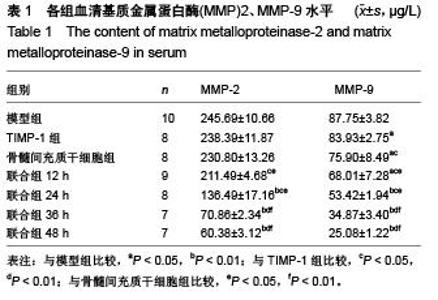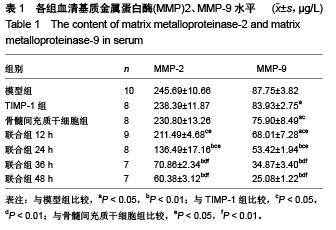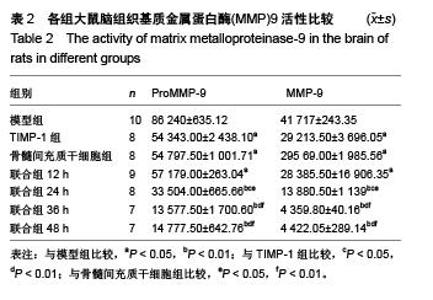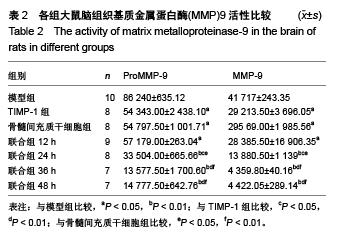Chinese Journal of Tissue Engineering Research ›› 2015, Vol. 19 ›› Issue (50): 8120-8125.doi: 10.3969/j.issn.2095-4344.2015.50.015
Previous Articles Next Articles
Effect of buyang huanwu decoction combined with bone marrow mesenchymal stem cell transplantation on cerebral ischemia-reperfusion injury
Zhang Yun-ke1, 2, Song Jun-ying1, Zhang Zhen-qiang1
- Zhang Yun-ke, M.D., Chief physician, Professor, Henan University of Traditional Chinese Medicine, Zhengzhou 450046, Henan Province, China; First Affiliated Hospital of Henan University of Traditional Chinese Medicine, Zhengzhou 450000, Henan Province, China
-
Received:2015-10-16Online:2015-12-03Published:2015-12-03 -
Contact:Zhang Zhen-qiang, M.D., Professor, Henan University of Traditional Chinese Medicine, Zhengzhou 450046, Henan Province, China -
About author:Zhang Yun-ke, M.D., Chief physician, Professor, Henan University of Traditional Chinese Medicine, Zhengzhou 450046, Henan Province, China; First Affiliated Hospital of Henan University of Traditional Chinese Medicine, Zhengzhou 450000, Henan Province, China -
Supported by:the National Natural Science Foundation of China, No. 81072799/H2708
CLC Number:
Cite this article
Zhang Yun-ke, Song Jun-ying, Zhang Zhen-qiang. Effect of buyang huanwu decoction combined with bone marrow mesenchymal stem cell transplantation on cerebral ischemia-reperfusion injury[J]. Chinese Journal of Tissue Engineering Research, 2015, 19(50): 8120-8125.
share this article
| [1] MacGregor DG, Avshalumov MV, Rice ME. Brain edema induced by in vitro ischemia: causal factors and neuroprotection. J Neurochem. 2003;85(6):1402-1411. [2] Steeg PS, Camphausen KA, Smith QR. Brain metastases as preventive and therapeutic targets. Nat Rev Cancer. 2011; 11(5):352-363. [3] Day RE, Kitchen P, Owen DS, et al. Human aquaporins: regulators of transcellular water flow. Biochim Biophys Acta. 2014;1840(5):1492-1506. [4] Newman KM, Jean-Claude J, Li H, et al. Cellular localization of matrix metalloproteinases in the abdominal aortic aneurysm wall. J Vasc Surg. 1994;20(5):814-820. [5] 张运克.补阳还五汤及拆方对脑缺血再灌注SD大鼠模型脑组织含水量及Ca2+含量的影响[J].中医药学刊,2003,21(11):1829-1830. [6] 高颖,蔡定芳.AO大鼠MMP-9蛋白表达及补阳还五汤干预作用[J].复旦学报:医学版,2003,30(5):470-473. [7] Zhang YK, Han XY, Che ZY. Effects of buyang huanwu tang combined with bone marrow mesenchymal stem cell transplantation on the expression of VEGF and Ki-67 in the brain tissue of the cerebral ischemia-reperfusion model rat. J Tradit Chin Med. 2010;30(4):278-282. [8] 张运克,高峰,张丹,等.补阳还五汤联合骨髓间充质干细胞移植对脑缺血再灌注大鼠脑组织NSE和GFAP表达的影响[J].中医杂志,2013,54(23):2043-2045. [9] 张运克,车志英,梅雪蕊. 补阳还五汤联合骨髓间充质干细胞移植对大鼠脑缺血再灌注模型神经细胞凋亡的影响[J].中华中医药学刊,2009,27(8):1660-1662. [10] 张运克,车志英,梅雪蕊.补阳还五汤联合骨髓间充质干细胞移植对脑缺血再灌注大鼠行为学及脑梗死体积的影响[J].辽宁中医杂志,2010,37(2):366-368. [11] 郭继强,刘爱兵,王东平,等.密度梯度离心法分离脐血干细胞:分离介质的筛选[J].中国组织工程研究,2013,17(23):4189-4195. [12] Rupadevi M, Parasuraman S, Raveendran R. Protocol for middle cerebral artery occlusion by an intraluminal suture method. J Pharmacol Pharmacother. 20112(1):36-39. [13] Legos JJ, Barone FC. Update on pharmacological strategies for stroke: prevention, acute intervention and regeneration. Curr Opin Investig Drugs. 2003;4(7):847-858. [14] 魏汝云,徐婧婧,王淑贞.基质金属蛋白酶-9与脑缺血损伤的关系研究进展[J].中国现代医学杂志,2007,17(5):565-568. [15] Hulkkonen J, Pertovaara M, Antonen J, et al. Matrix metalloproteinase 9 (MMP-9) gene polymorphism and MMP-9 plasma levels in primary Sjogren's syndrome. Rheumatology (Oxford). 2004;43(12):1476-1479. [16] Wu CY, Hsieh HL, Jou MJ, et al. Involvement of p42/p44 MAPK, p38 MAPK, JNK and nuclear factor-kappa B in interleukin-1beta-induced matrix metalloproteinase-9 expression in rat brain astrocytes. J Neurochem. 2004;90(6): 1477-1488. [17] Chakraborti S, Mandal M, Das S, et al. Regulation of matrix metalloproteinases: an overview. Mol Cell Biochem. 2003; 253(1-2):269-285. [18] Cuzner ML, Gveric D, Strand C, et al. The expression of tissue-type plasminogen activator, matrix metalloproteases and endogenous inhibitors in the central nervous system in multiple sclerosis: comparison of stages in lesion evolution. J Neuropathol Exp Neurol. 1996;55(12):1194-1204. [19] Maeda A, Sobel RA. Matrix metalloproteinases in the normal human central nervous system, microglial nodules, and multiple sclerosis lesions. J Neuropathol Exp Neurol. 1996; 55(3):300-309. [20] Rosenberg GA, Navratil M, Barone F, et al. Proteolytic cascade enzymes increase in focal cerebral ischemia in rat. J Cereb Blood Flow Metab. 1996;16(3):360-366. [21] Mandal M, Mandal A, Das S, et al. Clinical implications of matrix metalloproteinases. Mol Cell Biochem. 2003;252(1-2): 305-329. [22] Ramos-Fernandez M, Bellolio MF, Stead LG. Matrix metalloproteinase-9 as a marker for acute ischemic stroke: a systematic review. J Stroke Cerebrovasc Dis. 2011;20(1): 47-54. [23] Vlodavsky E, Palzur E, Soustiel JF. Hyperbaric oxygen therapy reduces neuroinflammation and expression of matrix metalloproteinase-9 in the rat model of traumatic brain injury. Neuropathol Appl Neurobiol. 2006;32(1):40-50. [24] Reyes R, Guo M, Swann K, et al. Role of tumor necrosis factor-alpha and matrix metalloproteinase-9 in blood-brain barrier disruption after peripheral thermal injury in rats. J Neurosurg. 2009;110(6):1218-1226. [25] Fujimoto M, Takagi Y, Aoki T, et al. Tissue inhibitor of metalloproteinases protect blood-brain barrier disruption in focal cerebral ischemia. J Cereb Blood Flow Metab. 2008; 28(10):1674-1685. [26] Zhang Y, Zhang P, Shen X, et al. Early exercise protects the blood-brain barrier from ischemic brain injury via the regulation of MMP-9 and occludin in rats. Int J Mol Sci. 2013;14(6):11096-11112. [27] 吴飞燕,罗利飞.补阳还五汤对急性脑梗死患者血浆超敏C反应蛋白及基质金属蛋白-9的影响[J].中国中医急症,2011,20(1): 14-15,32. [28] 王红祥,徐彬,万海同.黄芪对脑缺血-再灌注损伤大鼠MMP-9和IL-1β的影响[J].海峡药学,2013,25(4):17-19. [29] 李敬文,刘相轸,刘晓谦,等.川芎嗪对颈动脉球囊损伤后基质金属蛋白酶组织抑制物-1基因表达的影响[J].中国微侵袭神经外科杂志,2004,9(7):314-317. [30] 王栋,赵恒珂,孙银贵,等.红花注射液后处理对大鼠缺血再灌注心肌的保护作用探讨[J].临床合理用药杂志,2011,4(13):24-26. [31] 方顺淼,张清华.髓间充质干细胞移植修复动脉粥样硬化破裂斑块的研究[J].中华老年心脑血管病杂志,2012,14(11):1197-1200. |
| [1] | Jiang Tao, Ma Lei, Li Zhiqiang, Shou Xi, Duan Mingjun, Wu Shuo, Ma Chuang, Wei Qin. Platelet-derived growth factor BB induces bone marrow mesenchymal stem cells to differentiate into vascular endothelial cells [J]. Chinese Journal of Tissue Engineering Research, 2021, 25(25): 3937-3942. |
| [2] | Chen Yang, Huang Denggao, Gao Yuanhui, Wang Shunlan, Cao Hui, Zheng Linlin, He Haowei, Luo Siqin, Xiao Jingchuan, Zhang Yingai, Zhang Shufang. Low-intensity pulsed ultrasound promotes the proliferation and adhesion of human adipose-derived mesenchymal stem cells [J]. Chinese Journal of Tissue Engineering Research, 2021, 25(25): 3949-3955. |
| [3] | Zhang Lishu, Liu Anqi, He Xiaoning, Jin Yan, Li Bei, Jin Fang. Alpl gene affects the therapeutic effect of bone marrow mesenchymal stem cells on ulcerative colitis [J]. Chinese Journal of Tissue Engineering Research, 2021, 25(25): 3970-3975. |
| [4] | Ruan Guangping, Yao Xiang, Liu-Gao Miyang, Cai Xuemin, Li Zian, Pang Rongqing, Wang Jinxiang, Pan Xinghua. Umbilical cord mesenchymal stem cell transplantation for traumatic systemic inflammatory response syndrome in tree shrews [J]. Chinese Journal of Tissue Engineering Research, 2021, 25(25): 3994-4000. |
| [5] | Mo Jianling, He Shaoru, Feng Bowen, Jian Minqiao, Zhang Xiaohui, Liu Caisheng, Liang Yijing, Liu Yumei, Chen Liang, Zhou Haiyu, Liu Yanhui. Forming prevascularized cell sheets and the expression of angiogenesis-related factors [J]. Chinese Journal of Tissue Engineering Research, 2021, 25(22): 3479-3486. |
| [6] | Chen Lei, Zheng Rui, Jie Yongsheng, Qi Hui, Sun Lei, Shu Xiong. In vitro evaluation of adipose-derived stromal vascular fraction combined with osteochondral integrated scaffold [J]. Chinese Journal of Tissue Engineering Research, 2021, 25(22): 3487-3492. |
| [7] | Wei Qin, Zhang Xue, Ma Lei, Li Zhiqiang, Shou Xi, Duan Mingjun, Wu Shuo, Jia Qiyu, Ma Chuang. Platelet-derived growth factor-BB induces the differentiation of rat bone marrow mesenchymal stem cells into osteoblasts [J]. Chinese Journal of Tissue Engineering Research, 2021, 25(19): 2953-2957. |
| [8] | Chen Xiao, Guo Zhi, Chen Lina, Liu Xuanyong, Zhang Yihuizhi, Li Xumian, Wang Yueqiao, Wei Liya, Xie Jing, Lin Li. Factors affecting the mobilization and collection of autologous peripheral blood hematopoietic stem cells [J]. Chinese Journal of Tissue Engineering Research, 2021, 25(19): 2958-2962. |
| [9] | Guo Zhibin, Wu Chunfang, Liu Zihong, Zhang Yuying, Chi Bojing, Wang Bao, Ma Chao, Zhang Guobin, Tian Faming. Simvastatin stimulates osteogenic differentiation of bone marrow mesenchymal stem cells [J]. Chinese Journal of Tissue Engineering Research, 2021, 25(19): 2963-2968. |
| [10] | Li Congcong, Yao Nan, Huang Dane, Song Min, Peng Sha, Li Anan, Lu Chao, Liu Wengang. Identification and chondrogenic differentiation of human infrapatellar fat pad derived stem cells [J]. Chinese Journal of Tissue Engineering Research, 2021, 25(19): 2976-2981. |
| [11] | Gao Yuanhui, Xiang Yang, Cao Hui, Wang Shunlan, Zheng Linlin, He Haowei, Zhang Yingai, Zhang Shufang, Huang Denggao. Comparison of biological characteristics of adipose derived mesenchymal stem cells in Wuzhishan inbreed miniature pigs aged two different months [J]. Chinese Journal of Tissue Engineering Research, 2021, 25(19): 2988-2993. |
| [12] | Cao Yang, Zhang Junping, Peng Li, Ding Yi, Li Guanghui. Isolation and culture of rabbit aortic endothelial cells and biological characteristics [J]. Chinese Journal of Tissue Engineering Research, 2021, 25(19): 3000-3003. |
| [13] | Dai Min, Wang Shuai, Zhang Nini, Huang Guilin, Yu Limei, Hu Xiaohua, Yi Jie, Yao Li, Zhang Ligang. Biological characteristics of hypoxic preconditioned human amniotic mesenchymal stem cells [J]. Chinese Journal of Tissue Engineering Research, 2021, 25(19): 3004-3008. |
| [14] | Qin Yanchun, Rong Zhen, Jiang Ruiyuan, Fu Bin, Hong Xiaohua, Mo Chunmei. Chinese medicine compound preparation inhibits proliferation of CD133+ liver cancer stem cells and the expression of stemness transcription factors [J]. Chinese Journal of Tissue Engineering Research, 2021, 25(19): 3016-3023. |
| [15] | Dai Yaling, Chen Lewen, He Xiaojun, Lin Huawei, Jia Weiwei, Chen Lidian, Tao Jing, Liu Weilin. Construction of miR-146b overexpression lentiviral vector and the effect on the proliferation of hippocampal neural stem cells [J]. Chinese Journal of Tissue Engineering Research, 2021, 25(19): 3024-3030. |
| Viewed | ||||||
|
Full text |
|
|||||
|
Abstract |
|
|||||



